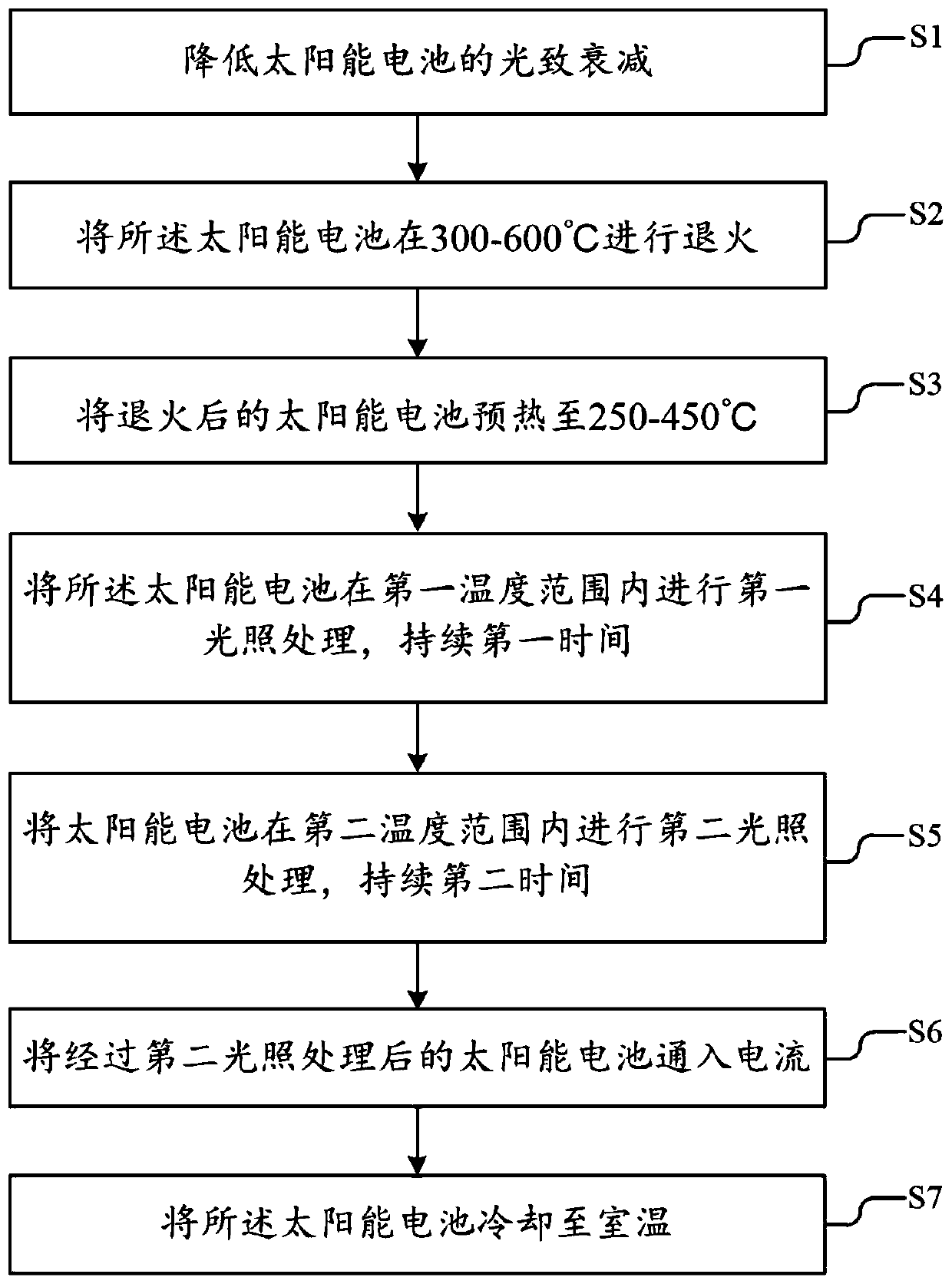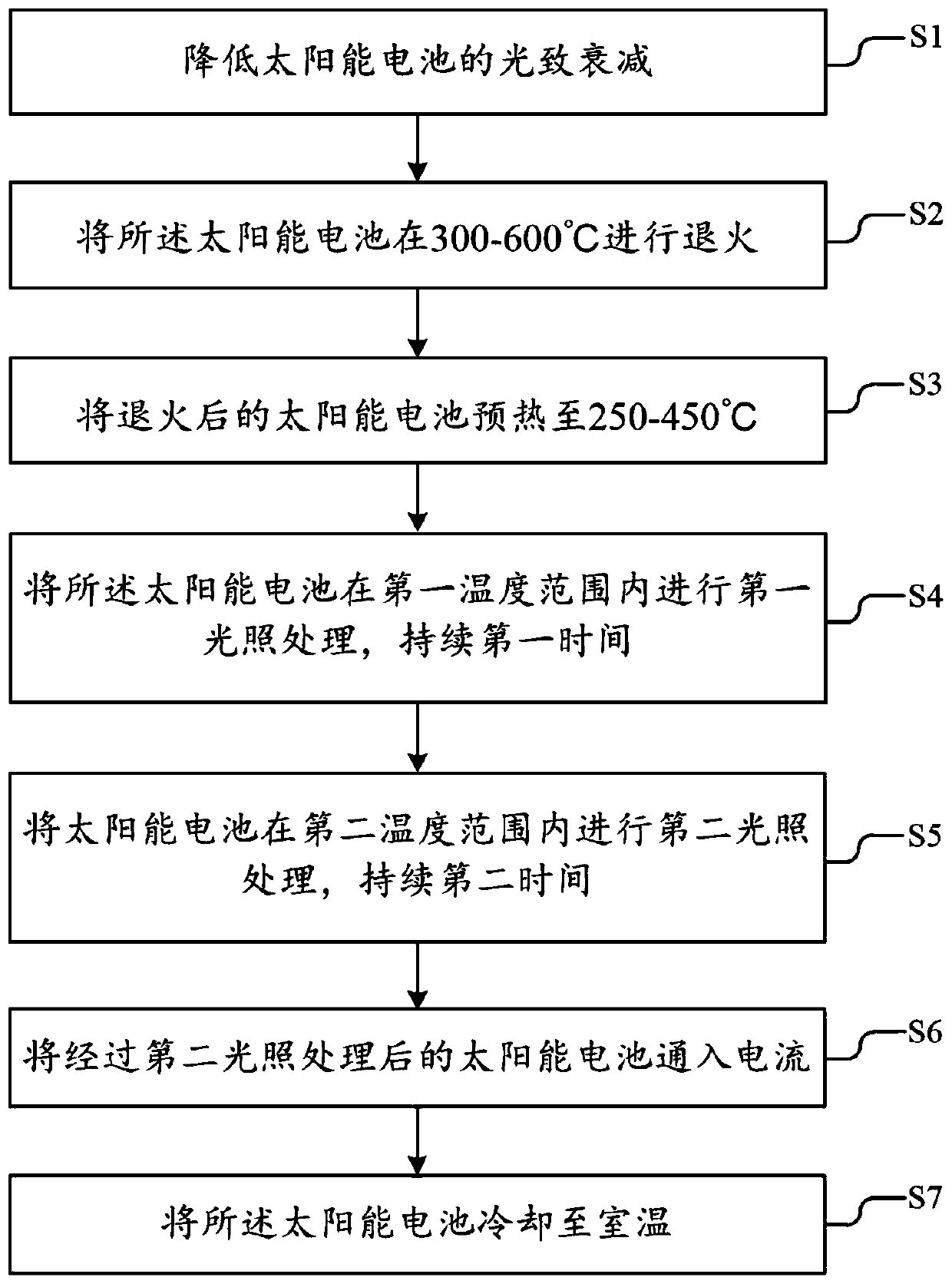Method and equipment for improving carrier attenuation of PERC solar cell
A solar cell and carrier technology, applied in the field of solar cells, can solve the problems of low LID test temperature, inability to effectively reduce CID, and inability to fully expose the risk of high temperature attenuation of PERC cells, so as to reduce the CID attenuation rate and improve conversion. The effect of efficiency
- Summary
- Abstract
- Description
- Claims
- Application Information
AI Technical Summary
Problems solved by technology
Method used
Image
Examples
Embodiment 1
[0104] This embodiment provides a method for improving carrier decay of a PERC solar cell, which specifically includes the following steps:
[0105] (1) reduce the light-induced attenuation of solar cells;
[0106] Specifically, use the method of ZL201811542505.5 to reduce the light-induced attenuation of solar cells; after this step, the LID is 0.9%; the CID is 2.3%;
[0107] (2) annealing the solar cell at 350°C;
[0108] Specifically, including:
[0109] (2.1) The solar cell is heated up to 350°C at a rate of 33°C / s, and the heating time is 10s;
[0110] (2.2) Insulate at 350°C for 4s;
[0111] (2.3) Cool the solar cell to 50°C at a rate of 10°C / s, and the cooling time is 30s.
[0112] (3) Preheat the solar cell to 350°C;
[0113] Among them, the heating rate is 30°C / s, and the preheating time is 10s;
[0114] (4) performing the first light treatment on the solar cell within the first temperature range for the first time;
[0115] Wherein, the first temperature range...
Embodiment 2
[0126] This embodiment provides a method for improving carrier decay of a PERC solar cell, which specifically includes the following steps:
[0127] (1) reduce the light-induced attenuation of solar cells;
[0128] Specifically, use the method of ZL201610091453.9 to reduce the light-induced attenuation of solar cells; after this step, the LID is 1.1%; the CID is 3.5%;
[0129] (2) annealing the solar cell at 400°C;
[0130] Specifically, including:
[0131] (2.1) The solar cell is heated up to 400°C at a rate of 25°C / s, and the heating time is 15s;
[0132] (2.2) Insulate at 400°C for 5s;
[0133] (2.3) Cool the solar cell to 58°C at a rate of 6°C / s, and the cooling time is 57s.
[0134] (3) Preheat the solar cell to 340°C;
[0135] Among them, the heating rate is 40°C / s, and the preheating time is 7s;
[0136] (4) performing the first light treatment on the solar cell within the first temperature range for the first time;
[0137] Wherein, the first temperature range i...
Embodiment 3
[0148] This embodiment provides a method for improving carrier decay of a PERC solar cell, which specifically includes the following steps:
[0149] (1) reduce the light-induced attenuation of solar cells;
[0150] Specifically, use the method of ZL201610091453.9 to reduce the light-induced attenuation of solar cells; after this step, the LID is 1.1%; the CID is 3.5%;
[0151] (2) annealing the solar cell at 400°C;
[0152] Specifically, including:
[0153] (2.1) The solar cell is heated up to 400°C at a rate of 25°C / s, and the heating time is 15s;
[0154] (2.2) Insulate at 400°C for 5s;
[0155] (2.3) Cool the solar cell to 30°C at a rate of 5°C / s, and the cooling time is 74s.
[0156] (3) Preheat the solar cell to 340°C;
[0157] Among them, the heating rate is 40°C / s, and the preheating time is 7s;
[0158] (4) performing the first light treatment on the solar cell within the first temperature range for the first time;
[0159] Wherein, the first temperature range i...
PUM
 Login to View More
Login to View More Abstract
Description
Claims
Application Information
 Login to View More
Login to View More - R&D
- Intellectual Property
- Life Sciences
- Materials
- Tech Scout
- Unparalleled Data Quality
- Higher Quality Content
- 60% Fewer Hallucinations
Browse by: Latest US Patents, China's latest patents, Technical Efficacy Thesaurus, Application Domain, Technology Topic, Popular Technical Reports.
© 2025 PatSnap. All rights reserved.Legal|Privacy policy|Modern Slavery Act Transparency Statement|Sitemap|About US| Contact US: help@patsnap.com



